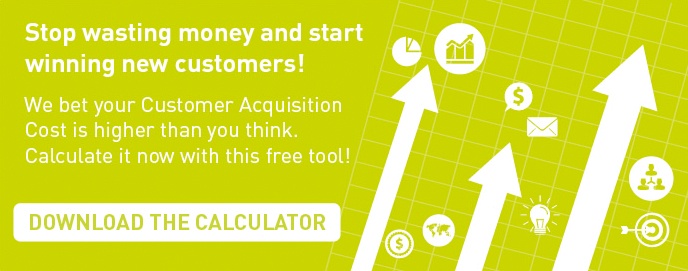How Can You Get a Better Return on Marketing Investment?

If cash flow is the life-blood of a business, then new business is the beating heart. A business cannot grow without new business; in fact, without it, it will whither on the vine. But winning new business is only part of the story. You not only need to ensure that the work you win is profitable, but also how you win it is profitable.
According to Amplitude, most average-sized tech companies spend around 10-20% of their revenue on marketing and sales, and some early Saas companies can spend up to 120%
As we have seen in the article "Customer Acquisition Cost: the Secret to your B2B Success", customer acquisition costs (CAC) are rising, but that doesn't mean that business' profitability is too.
The simple secret to success is essentially to make sure that your customers' lifetime value (LVT) is greater than your CAC.
Download the free customer acquisition cost calculator and see how much you are really spending on marketing
Dropbox' early paid search campaign saw a CAC of $233-388, while their product was only $99. It didn't take them long to realise that this wasn't a strategy for sustainable growth, and they are only one example among many others that are committing the same mistake.
Thanks to the Purple Frog free CAC calculator, it's now easy to see at a glance how much your current CAC is and the state of your business, which is certainly the first step towards success, but once you have understood that, how can you improve your return on marketing investment?
As the McKinsey group states in Forbes, "before placing your bets on a horse race, it would be nice to know which horse would win." However, with an ever-changing business landscape and new technologies coming out every day, it's becoming increasingly harder to know which one is going to be your "winning horse". Here are a few tips on finding out the right strategy for your business.
Traditional marketing is dead
As we always say, there is no point in splashing advertising left and right, without seriously considering whether it's going to guarantee you a real return on your investment, but just hoping to pick up some business along the way.
Marketing has to always guarantee you a return, hence why the old advertising tricks are not good enough any more.
According to David Court and Jonathan Gordon at McKinsey, "the declining effectiveness of mass advertising is only the most visible sign of distress. Marketers also face a general proliferation of media and distribution channels, declining trust in advertising, multitasking by consumers, and digital technologies that give users more control over their media time. These trends are simultaneously fragmenting both audiences and the channels needed to reach them. The danger for marketers is that change will render the time-honoured way of getting messages to consumers through TV commercials less effective at best, and a waste of time and money at worst."
Marketing should never be a cost, but an investment, and in order to be so, new techniques need to be explored and measured all the time.
Stop "backcasting" and start "forecasting"
The team at McKinsey coined these words to explain the concept that customers' behaviours are changing quickly, and relying solely on the past is not enough any more. The traditional marketing mix is great for backcasting, but in order to go forwards you need to integrate it with insight from your managers, who have deep knowledge of the industry and understand issues like media inflation and contracted obligations.
Industry reports and trends and patters from other companies in your sector are also a great way to see where the industry is going and not get fossilised in what has worked in the past.
Categorise your activities
Measuring the success of all of your marketing activities is potentially the single most important thing you could do to guarantee you will get a return from them. However, we understand that you can't always see a direct result for all of your marketing activities, especially for those that are aimed at increasing brand awareness, or developing pricing strategies, for example. Sam Ashe-Edmunds, in an article on Chron, said that you should categorise your marketing efforts into areas that produce tangible and intangible results, and create measurements for each.
Focus your spend
When companies try and increase their return, their first port of call is to reduce their marketing and sales costs. While this will save you cash in the immediate future, it will have a negative impact on your revenue and sales growth in the long term. The trick, instead, is to focus your investments and find out what channel is right for attracting the right target persona.
In order to improve poorly-performing marketing activities, Sam Ashe-Edmunds suggests using your website analytics. These will enable you to analyse whether, for instance, your social media marketing is generating leads or sales on your website, your blog is actually effective in attracting more people onto the website, etc. It might mean that you are using a strategy that your target persona is not really interested in, and therefore your team should focus more on finding out how to reach potential customers in another way or write more content that is tailored for them.
Another important thing to do is to keep testing fresh ideas and analyse the results before committing huge amounts of money to them. There are also some cost-effective marketing activities out there that you aren't considering yet that might be worth exploring, such as inbound marketing, so trying them out and analysing the results could lead you to finding a new channel that will enable you to get a higher return on your investment.
Identify your plateaus
As the team at McKinsey explains, an X% increase in investment in a given channel, doesn't mean a steady Y% improvement in effectiveness in every case. The increase will more likely be in the form of a curve, where the value of investment in a channel will diminish when you hit your plateau.
You should determine where that plateau point is and draw back you investment in that channel, moving it onto those with more room for growth.
Conclusion
Finding a strategy that is focussed on your target persona, experimenting with new marketing channels and measuring everything thoroughly will always guarantee you will see a return on your marketing spend and have a successful and sustainable customer acquisition strategy, which will in turn grow your business.
How do you make sure you are getting a good return on your marketing investment?
More from Strategy

Is the Way you Budget Your Marketing Spend Wrong?
Marketing should never be a blind gamble, but a calculated risk that always guarantees you a return. If this seems like an...
Why Should I Use Inbound Marketing?
Since 2006, inbound marketing has been the most effective method for doing business online, this is because it generates 3x...






